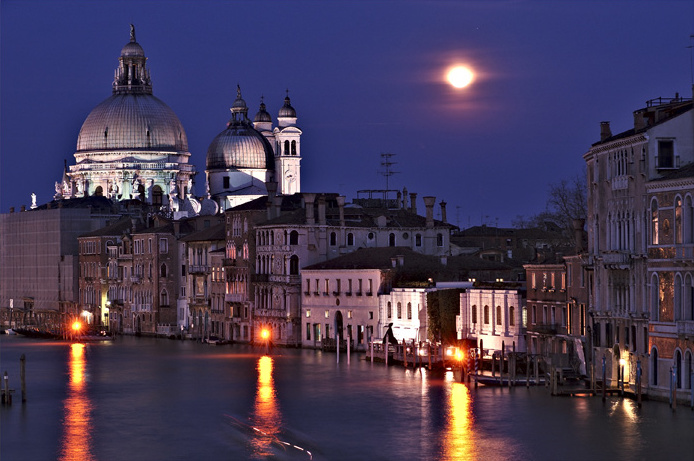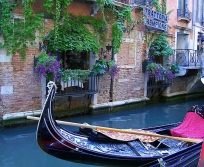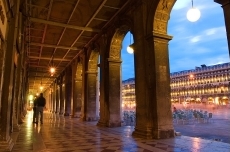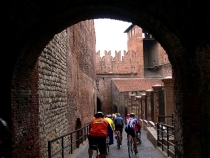Veneto
Vèneto is one of the regions of Italy. It is located in the northeastern part of the country, bordering on the Italian regions of Emilia-Romagna and Lombardy, the autonomous regions of Trentino-South Tyrol and Friuli Venezia Giulia and Austria. It lies between the Alps and the Adriatic Sea and is traversed by the rivers Po, Adige, Brenta and Piave.
The capital is Venice. Other important towns include Verona, Padua, Treviso, Belluno, Rovigo and Vicenza. This region is very rich in cultural and historic treasures. Its architectural heritage includes the unique buildings and bridges of Venice, and many of Palladio's villas. Verona's arena is an ancient Roman amphitheatre, traditionally reserved for opera. The University of Padua is one of the oldest (1222) in Europe and has counted among its many famous professors Galileo Galilei. To this day it is world renowned for being at the forefront of medicine.
Veneto is one of the two Italian Regions whose inhabitants are granted the status of «popolo» (i.e. people) with Constitutional Law by the Italian Parliament, the other being Sardinia Regional Constitution of Veneto.
Provinces
History
The Venetic Period
Between 2nd and 1st milleniums BCE the region is inhabited first by Euganei and later by Veneti who came here from the Balcans. In 6th-7th centuries BCE the local populations entered in contact with the Etruscans and Greeks.
see also:
The Roman Period
Mostly together with the Cenomani Celts on their western border, the Veneti sided with the Romans when Rome struggled against the Insubri and Boi Celts during the 3rd Century BCE. Since the 2nd Century BCE, the Roman Republic gradually transformed the Veneti alliance into dominance. After the 91 B.C. Italic rebellion, the Veneti allied cities, together with the rest of Transpadania, were granted part of the rights of the Roman citizenship (Lex Pompeia Transpadanis). Later in 49 B.C., the Lex Rubria de Gallia granted full Roman citizenship to the Veneti. After the Battle of Filippi (42 B.C.), which ended the civil war, the Veneti, together with the rest of Cisalpine Gaul, ceased to be a province and became the X region (Venetia et Istria) of a new entity named Italia (Italy).
In the Roman empire Patavium (modern Padua) became one of the most important cities of northern Italy.
Middle Ages
Escaping from the barbaric invasions the parts of Veneto's population occupied some of the isolated islands of lagoon, so the Venice was born. After the period of Byzantine domination in 8th century, Venice became an independent marine Republic. The rest of the territory was subdivided in numerous feuds.
The Serenissima: The Republic of Venice
A commercial superpower that lasted through the Middle Ages and the Renaissance it enjoyed 1100 years of uninterrupted influence in the Mediterranean. The Venetian Republic ruled Veneto, Friuli, part of Lombardy and Romagna from XV - XVI centuries.
See also:
The Modern Veneto
Attacked by Napoleon disappeared as an autonomous state in 1797 and was given under the Austrian domination. In 1866 after the 3rd Independence War Veneto joined Italy. The 19th century: economic depression, the Italian period and the massive migrations to the Americas.
Politics
Once a stronghold of the Christian Democracy, Veneto is now a stronghold of the centre-right House of Freedoms coalition, which governs the region from 1995, under President Giancarlo Galan (Forza Italia). Veneto is also home for Venetism, a political movement which appeared during the 1970s and 80s, proclaiming autonomy for the region, considered as a nation separated from Italy, and promoting Venetian culture, language and history. This is the political background in which was founded in 1979 the Liga Veneta (leading autonomist party, founding member of Lega Nord in 1991), and then other parties such as the Liga Fronte Veneto and the North-East Project. The Liga Veneta scores always between 10 and 30%, and in the 2006 regional elections the three parties combined gained 21,5% of the votes. However, from 1999 the strongest party in the region is Forza Italia, led by combactive and autonomist Galan, who forged a strong axis with the Liga Veneta-Lega Nord.
Economy
Until the 1950s this region was one of the poorest among the north-Italian regions. For a long time continued emigration flow to other parts of the country (Milan and Turin).
Agriculture
The agriculture of the region progressed a lot during the past 20-30 years. The territory of Veneto is still dominated by little farmer property and agriculture is mixed. The other phenomenon is part-time work in agricultural sector, that is after the working-day on a factory people cultivate their private pieces of land. Among the principle plants should be noticed: maize, green pea, vegetables, apple, cherry, sugar beet, forage, tobacco, hemp. In the hill zones is spread the production of grape and excellent wines. Very well developed the breeding of cattle and fishing.
Industry
Thanks to ancient traditional artisan activities industry takes its origins from the past century in some pre-Alpine valleys. During the last 30-40 years industrialization changed the look of numerous landscapes, especially in the plain, where grew hundreds of industrial complexes. In zones if Marghera and Mestre were built metallurgical and chemical plants. In other parts of the region were affirmed little and medium activities in various sectors: food, textile, chemistry, metal-mechanics, glass, electrotechnics, sight glasses (exported). Artisan production is also quite strong: Muran glass, laces of Burano and gold production of Vicenza. Apart from agriculture and industry should be noticed such activities as commerce, banking and tourism.
Climate
The variations in climate are influenced, by the particular morphology. Continental on the plains, the climate is milder along the Adriatic coast, round Lake Garda and in the open hilly areas. The winter is harsh, everywhere, due to northeasterly winds. Precipitation is scarce (750 mm. /year) on the lower plain, especially near river Po, more abundant (750-1,100 mm./year) on the upper plain; the highest values (up to 3,200 mm./year) are recorded in the Bellunese Prealps, near Pasubio and on the Asiago plateau.
Venice : January: 0.9 C July: 21.6 C
Main tourist attractions
Veneto region ranks first in the tourist sector in Italy with about 60 million of tourists every year.
- Veneto.org - Extensive tourist info with 1500+ hotels links and more.
- Portal for tourists of Regione Veneto
The Cities of Art
Venice: The kaleidoscopic scenario born of an amazing, intricate and harmonious communication network of water and stone casts light and shadows unique in the world upon a city already singular for its art, history and culture.
Venice and its lagoon are listed as World Heritage Sites by UNESCO.
Verona: The city of the most famous lovers in history: Romeo and Juliet.It is one of the cities that has better preserved its artistic heritage in Italy.
Verona has been named a UNESCO world heritage site.
 File:Padua 2.jpg File:Padua 3.jpg File:Padua 4.jpg
File:Padua 2.jpg File:Padua 3.jpg File:Padua 4.jpg
Padua: also known as the City of the Saint, is a city of huge importance for its cultural, historical and economic aspects and it's on UNESCO's list of World Heritage Sites.
File:Vicenza 1.jpg  File:Vicenza 3.jpg
File:Vicenza 3.jpg
Vicenza is on UNESCO's list of World Heritage Sites, together with a number of the Palladian Villas.
Montagnana is a commune in the province of Padova with great famous perfectly conserved medieval walls
Bassano del Grappa with his wooden covered Bridge or Ponte degli Alpini on the river Brenta, designed in 1569 by the architect Andrea Palladio
Marostica : The 'Chess Game' event takes place on the second weekend of September and it involves over 550 characters and last two hours.
Asolo is known as 'The Pearl of province of Treviso', and also as 'The City of a Hundred Horizons'.
Este : The House of Este held the city until 1240, when they moved their capital to Ferrara.
Ville Venete
File:La Rotonda little.jpg File:Villa cornaro.jpg 

All over the Venetian plain, but especially in the Provinces of Treviso, Padua, Vicenza and Venice, stand numerous remarkable artistic rural constructions, the Ville Venete. Dates of construction of these villas range from the fifteenth to the nineteenth centuries. There are approximately five thousand Ville Venete, of which 1,400 are declared of historical and monumental interest.
- CISA : The Centro Internazionale di Studi di Architettura Andrea Palladio (Palladio Centre and Museum) in Vicenza is an independent Foundation, supported by the Veneto Regional Government and by the Italian state
Mountains & Lakes
Lake Garda: the area is a major tourist destination with the picturesque lakeside resorts of Lazise, Cisano, Bardolino, Garda, Torri del Benaco and Malcesine, which offer the possibility of a quiet holiday, made more pleasurable by a mild climate and a Mediterranean-type environment.
Cortina d'Ampezzo: Probably among the three most exclusive mountain locations in Europe, Cortina is known for its first-class hotels and shops.
Arabba, between the Sella group and the Marmolada.
Sappada, in the extreme north of the region;
Thermal Bath
The thermal baths at Abano Terme are also an attraction. Although the most famous, Abano is by no means the only thermal town in the area. It is however one of the prettiest and most tranquil.
Beaches
Venice's Lido is an 11-mile long sandbar, home to about 20,000 residents, greatly augmented by the (mainly Italian) tourists who move in every summer.
Jesolo is one of the most important seaside resort on the Adriatic coast, just few kilometers far from Venice. Every year Jesolo accommodates over 10 millions of tourists.
Caorle: it is extremely pleasant to spend some time swimming in Caorle’s beautiful blue sea or sunbathing in its golden beaches, often awarded for being one of the cleanest beaches in Italy.
Bibione The clear and gentle Adriatic Sea, offer to Bibione a wide beach of golden sand. It is 10 km long, Bibione is also an important and fully equipped thermal resort
Eraclea is a small and tranquil paradise right in the middle of pine forests.
Food and Wines
There are some fine wines from the Veneto region of Italy, these include: Soave, Bardolino, Recioto, Amarone, Torcolato, Prosecco, Tocai Rosso,Garganega and Valpolicella and some fine cheeses like Asiago (PDO) (from Asiago), Monte Veronese (PDO), Piave (PDO), Morlacco , Grana Padano (PDO).
Garda and Veneto olive oils (PDO) are other remarkable products of this region.
Fresh & Cured Meats
The Sopressa Vicentina (PDO) is an aged salami, cylindrical in shape and prepared with raw, quality pork meat. It may or may not include garlic in its ingredients and comes in medium and large sizes.
Prosciutto Veneto Berico-Euganeo (PDO) is obtained from the fresh meat of a top breed of adult hogs. The aroma is delicate, sweet and fragrant.
Cereals, Vegetables & Fruits
Radicchio Rosso di Treviso (PGI) is a peculiar vegetable with a faintly bitter taste and a crunchy texture. The production area encompasses many town districts in the provinces of Treviso, Padua and Venice.
The Radicchio Variegato di Castelfranco (PGI) has a delicate and slightly sweet taste and a crunchy texture.
Veronese Vialone Nano Rice from Verona (PGI) : a white rice with short, plump grains, which have a creamy consistency when cooked. They are commonly used in risotto dishes and have a high starch content.
The Bean of Lamon (PGI) type is particularly prized for its delicate flavour and extremely tender skin.
The White Asparagus of Cimadolmo (PGI) has a characteristic scent and a very delicate taste.
The White Asparagus of Bassano is a delight of northern Vicentino, is a shoot which has not yet broken the earth and owes its characteristic whiteness to its brief underground existence.
The S.Zeno di Montagna (Verona) chestnut (PDO) with its sweet taste.
Cerries of Marostica (PGI) in those the pulp varies in consistency from crisp to soft and the flavour is finely graded from sour to sweet.
Miscellaneous
According to Robert Putnam,[1] the "institutional performance" of Veneto's regional government is higher than average in Italy, thus Veneto belongs to what Putnam defines as "civic North". Veneto has a long tradition of high quality public health care, which can be traced to the historical heritage of the Republic of Venice.
Less satisfactory is the sector of schools, because the percent of people who finished high school and college or University is smaller than average Italian one.Template:Verify source
Veneto is also the name of the main battleship class which Italian navy possessed during World War II. The Veneto class battleship includes Vittorio Veneto and Rome. Both ships were damaged in the famous Taranto raid of the British Royal navy and participated in most of the major sea battles between Britain and Italy in the Mediterranean.
Notable people from Veneto
- Titus Livius (around 59 BC - AD 17), known as Livy in English, wrote a monumental history of Rome, Ab Urbe Condita, from its founding (traditionally dated to 753 BC) through the reign of Augustus.
- Gaius Valerius Catullus (ca. 84 BC – ca. 54 BC) was one of the most influential Roman poets of the 1st century BC.
- Marco Polo (September 15 1254, Venice; January 8, 1324, Venice) was a Venetian trader and explorer
- Andrea Mantegna(c. 1431,Isola di Carturo now Isola Mantegna (Padova) , Italy – September 13, 1506, Mantua) was the first truly Renaissance artist of Northern Italy.
- Giorgione (c. 1477 — 1510) is the familiar name of Giorgio Barbarelli da Castelfranco, one of the seminal artists of the High Renaissance in Venice.
- Titian or Vecellio (c. 1488-90 – August 27, 1576) was the leader of the 16th-century Venetian school of the Italian Renaissance.
- Andrea Palladio (November 30, 1508 – August 19, 1580), was an Italian architect, widely considered the most influential person in the history of Western architecture.
- Tintoretto (real name Jacopo Robusti; 1518 - May 31, 1594) was one of the greatest painters of the Venetian school and probably the last great painter of Italian Renaissance.
- Benedetto Marcello (born July 31 or August 1, 1686 in Venice - died July 24, 1739 in Brescia) was a composer, writer, advocate, magistrate, and teacher.
- Antonio Vivaldi (March 4, 1678, Venice – July 28 (or 27), 1741, Vienna), nicknamed Il Prete Rosso ("The Red Priest"), was a priest and baroque music composer, as well as a famous violinist.
- Goldoni (February 25, 1707 - February 6, 1793), Along with Pirandello, Goldoni is probably the most famous name in Italian theatre, in his country and abroad.
- Giovanni Battista Piranesi(4th October 1720 in Mogliano Veneto (near Treviso) - 9th November 1778 in Rome) was famous for his etchings of Rome and of fictitious and atmospheric "prisons" (Carceri d'Invenzione).
- Giacomo Casanova (aka Jacques Casanova; April 2, 1725 - June 4, 1798, in Dux, Bohemia, now Duchcov, Czech Republic) was a famous Venetian adventurer, writer and womanizer.
- Antonio Canova (November 1, 1757 - October 13, 1822) was an sculptor who became famous for his marble sculptures that delicately rendered nude flesh.
- Pius X (Latin: Pius PP. X) born Giuseppe Melchiorre Sarto was born June 2, 1835 in Riese, Province of Treviso.
- John Paul I, (in Latin Ioannes Paulus PP. I), born Albino Luciani (October 17, 1912 – September 28, 1978), reigned as pope and as sovereign of Vatican City from August 26, 1978 to September 28, 1978.
- Federico Faggin(born 1 December 1941) is a physicist and electrical engineer considered to be one of the inventors of the microprocessor.
- Benetton is a global upmarket clothing brand, based in Treviso, Italy.
- Dino Meneghin (born January 18, 1950) is an Italian former basketball player. He was considered the best player for his country for decades, and, for several years, also the best in Europe.
- Sara Simeoni(born April 19, 1953) is a former high jumper, who won a gold medal at the 1980 Summer Olympics and set two times a world record in her speciality.
- Riccardo Patrese(born April 17 1954) is a former Formula One (F1) racing driver, from 1977 to 1993.
- Renzo Rosso (born 1955) is a clothing designer and founder of the Diesel clothing company.
- Roberto Baggio (born February 18, 1967) is a legendary Italian former footballer, among the best players in the world throughout the 1990s.
External links
- Regione Veneto — Official homepage
- Map of Veneto
- Photos of Venice
- University of Padova.
- University of Verona.
- University of Rovigo.
- University of Venezia "Ca' Foscari".
- University of Venezia "IUAV".
- Padova Airport.
- Verona Airport.
- Venice Airport.
- Vicenza Airport.
- Treviso Airport.
| Regions of Italy | ||||
|---|---|---|---|---|
| Abruzzo • Aosta Valley • Apulia • Basilicata • Calabria • Campania • Emilia-Romagna • Friuli-Venezia Giulia • Lazio • Liguria • Lombardy • Marche • Molise • Piedmont • Sardinia • Sicily • Trentino-South Tyrol • Tuscany • Umbria • Veneto | ||||
- ↑ Putnam, R. D.: "Making Democracy Work. Civic traditions in modern Italy", Princeton, NJ: Princeton University Press, 1993







